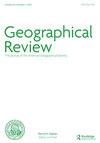WHALE SNOW: Iñupiat, Climate Change, and Multispecies Resilience in Arctic Alaska
IF 1.4
3区 社会学
Q2 GEOGRAPHY
引用次数: 4
Abstract
With increasing public environmental consciousness evinced by the rise of sustainability-based educational curricula and the mainstreaming of the socalled environmental movement, it can sometimes be easy to forget that the United States remains a whaling nation, one of only four in the world given quotas for aboriginal subsistence whaling by the International Whaling Commission. American whaling is often construed as an element of the real and literary past, statically captured in such maritime classics as Moby-Dick and In the Heart of the Sea. Geographer Chie Sakakibara’s Whale Snow—which would hold its own on a bookshelf alongside Melville’s (1851) and Philbrick’s (2000) volumes—introduces, or for some, reintroduces, a contemporary American community for whom whaling remains central to its cultural, spiritual, and physical subsistence: the Iñupiat of Alaska, centered in the Arctic communities of Point Hope and Utqiaġvik (formerly called Barrow). The product of multigenerational and multispecies relationships more than 15 years building, this book is the new academic standard on Alaskan whaling in a time of rapid environmental and societal change. The word Iñupiat, like many of the world’s indigenous demonyms, means “real people.” Sakakibara shows how the connections they forge with whales, whaling, and whaler ancestors help the Iñupiat “remain resilient and real when the ocean rises” (xiv). This is done, in part, by reinforcing old traditions: cultural, like the aġġi or drum dance (Chapter 5); temporal, like “the whaling cycle”—a calendar that prescribes whaling-related activities throughout the year in preparation for the main spring hunting season and the secondary autumn hunt (Chapter 1); or sociological, like the system of human organization based upon whaling crews and their families. Resilience and realness are also reinforced through adaptation: geographical, as illustrated by the wholesale movement of an entire community from its original site, now lost to rising seas (Chapter 4); spiritual, as with the simultaneous “Indigenization of Christianity and Christianization of Indigeneity” (146); and political, as memorably illustrated in a chapter titled “The New Harpoon” (Chapter 3). The literal new harpoon—a Norwegian introduction with an exploding head—plays only a minor role here; the new harpoon in the chapter’s title is a metaphorical one: the Alaska Native Claims Settlement, a political tool (others writing about whaling have referred to harpoons as “weapons”) focused on “subsistence rights, land claims, and鲸鱼雪:Iñupiat,气候变化和阿拉斯加北极的多物种恢复力
随着以可持续发展为基础的教育课程的兴起和所谓的环境运动的主流化,公众的环境意识日益增强,人们有时很容易忘记美国仍然是一个捕鲸国家,它是世界上仅有的四个被国际捕鲸委员会授予土著生存捕鲸配额的国家之一。美国的捕鲸经常被认为是真实的和文学过去的一个元素,在诸如《白鲸记》和《在海洋的中心》等海洋经典中被静态地捕捉到。地理学者赤叶·坂原的《鲸鱼之雪》将与梅尔维尔(1851年)和菲尔布里克(2000年)的著作一起放在书架上,它介绍了,或者对一些人来说,重新介绍了一个当代美国社区,对他们来说,捕鲸仍然是其文化、精神和物质生存的核心:阿拉斯加的Iñupiat,以北极地区的希望角和Utqiaġvik(以前称为巴罗)为中心。这本书是多代和多物种关系的产物,超过15年的建立,是在环境和社会迅速变化的时代,阿拉斯加捕鲸的新学术标准。Iñupiat这个词,就像世界上许多本土的恶魔一样,意思是“真实的人”。Sakakibara展示了他们如何与鲸鱼、捕鲸和捕鲸祖先建立联系,帮助Iñupiat“在海平面上升时保持弹性和真实”(xiv)。这在一定程度上是通过强化古老的传统来实现的:文化,如aġġi或鼓舞(第5章);暂时的,比如“捕鲸周期”——一种规定全年与捕鲸有关的活动的日历,为主要的春季捕鲸季节和次要的秋季捕鲸季节做准备(第1章);或者是社会学的,比如以捕鲸船员和他们的家庭为基础的人类组织体系。复原力和真实性也通过适应得到加强:地理上,正如整个社区从原来的地点大规模迁移所说明的那样,现在由于海平面上升而消失(第4章);精神上,如同时“基督教本土化和本土化的基督教化”(146);政治方面,在第三章“新鱼叉”一章中有令人难忘的说明。字面上的新鱼叉——一个带有爆炸头的挪威人的介绍——在这里只起了很小的作用;章节标题中的新鱼叉是一种隐喻:阿拉斯加原住民索赔解决方案,一种政治工具(其他关于捕鲸的文章将鱼叉称为“武器”),专注于“生存权,土地要求和法律”
本文章由计算机程序翻译,如有差异,请以英文原文为准。
求助全文
约1分钟内获得全文
求助全文
来源期刊

Geographical Review
GEOGRAPHY-
CiteScore
4.80
自引率
10.00%
发文量
24
期刊介绍:
One of the world"s leading scholarly periodicals devoted exclusively to geography, the Geographical Review contains original and authoritative articles on all aspects of geography. The "Geographical Record" section presents short articles on current topical and regional issues. Each issue also includes reviews of recent books, monographs, and atlases in geography and related fields.
 求助内容:
求助内容: 应助结果提醒方式:
应助结果提醒方式:


